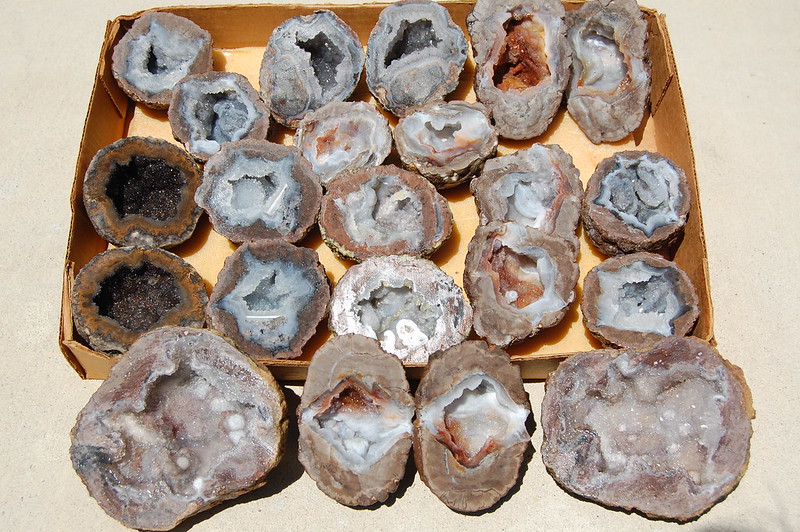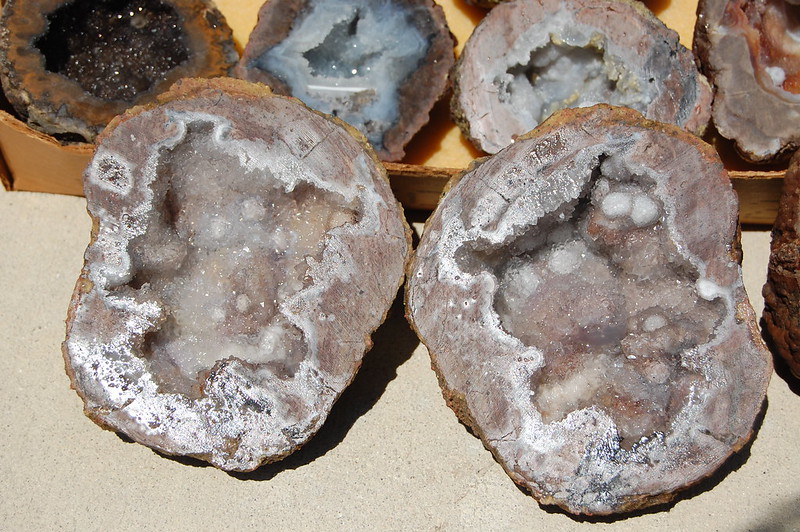|
|
Post by HankRocks on Sept 8, 2017 16:08:14 GMT -5
12 out of 13 were hollow and crystal lined. I am beginning to think that they are not Thundereggs, not sure;  DSC_0070 DSC_0070 by Findrocks, on Flickr  DSC_0073 DSC_0073 by Findrocks, on Flickr As I said they look more like a variety of Geode rather than the classic Thundereggs. either way I am happy with the outcome. Henry |
|
Deleted
Deleted Member
Member since January 1970
Posts: 0
|
Post by Deleted on Sept 8, 2017 16:13:17 GMT -5
Some look like Dugway geodes from Utah (bottom). Others look like Mexican Coconut geodes (left). A few might still be thundereggs (top and right). I'd be happy with that bunch, too.
|
|
Don
Cave Dweller  He wants you too, Malachi.
He wants you too, Malachi.
Member since December 2009
Posts: 2,616
|
Post by Don on Sept 8, 2017 16:18:24 GMT -5
They're thunder eggs, but I disagree about them being utah dugway eggs. the matrix doesn't look right, nor the iron staining in some of them. That dark on on the left looks like mexico to me. The others, I'd guess wiley wells or hauser.
|
|
|
|
Post by HankRocks on Sept 8, 2017 16:26:06 GMT -5
I just googled Dugway Geode images and most look just like what I cut except for two that are likely Mexican Geodes.
|
|
Deleted
Deleted Member
Member since January 1970
Posts: 0
|
Post by Deleted on Sept 8, 2017 16:31:49 GMT -5
I just googled Dugway Geode images and most look just like what I cut except for two that are likely Mexican Geodes. If you look at the shell of that bottom photo (zoomed in), I'm seeing layering in the shell itself, which is characteristic of every Dugway geode I've ever seen. The pieces with the star-shaped interiors (which indicate they formed under pressure) have a better chance of being thundereggs. Interiors of others look like there may be some calcite, which may be more indicative of geodes than thundereggs. The outer shells can tell more about what you have than the hollow interiors. Quite a variety there. |
|
|
|
Post by HankRocks on Sept 8, 2017 17:12:37 GMT -5
Just curious, is there a picture guide for Geode/T-egg exteriors and interiors that help identify type and origin.
Typing this I do realize I was in the one place 3 months ago where I could have made identifications, The Geode Kid's collection in the Deming Museum. Now if only I had an Photographic Memory!!
Henry
|
|
lookatthat
Cave Dweller  Whatever there is to be found.
Whatever there is to be found.
Member since May 2017
Posts: 1,360 
|
Post by lookatthat on Sept 8, 2017 17:23:25 GMT -5
A lovely bunch of coconuts! OK, I know they're not all coconuts, but I couldn't resist. That's a really nice bunch, what fun  |
|
|
|
Post by socalagatehound on Sept 8, 2017 19:08:15 GMT -5
Hi all
Aren't all lithophysae thundereggs, but the hollow ones are geodes?
I have a collection of around 600 geodes and thundereggs from when I was really into it about 15 years ago (before I switched my attention to agates). Some of what you have would require closer examination of the matrix and a look at the back to determine origin.
From what I can see, of those in the tray, the one with black crystals and gold rind is definitely a coconut geode from Las Choyas. The one right next to it is very likely a Zacatecas, because their rinds are grainy and polish poorly. Zacatecas can range from what you see in that one to amethyst, rock crystal and dogtooth calcite centers. They can get big, over 2 feet. I have several in my cabinets over 10 inches in diameter with all of the above interiors. The pair of halves above that and the pair on the bottom right appear to be Trancas (Chihuahua). Trancas are some of my favorites. Thin walled with crazy interiors. Those right in the middle could be red-skin geodes (also from Chihuahua). Top right looks like a potato geode. Top middle I have no guess without seeing the rind. Might be a coconut. Bottom row...flip them face down. If the skin is white-ish or pale, with flow lines, they are probably Dugway. If the big one has thick pressure lines and is rough and almost crumbly feeling, it's probably Zacatecas. But Zacatecas will have freckles in the matrix. In the picture, if those are flow lines on the rind, and not saw marks, I'd bet Dugway. The middle one could be Dugway too, but if the skin is red then it's likely either red skin or a potato geode (both are old commercial names for Mexican sourced geodes). Hope this helps. I'm sure there are things I've forgotten or some recent finds I have not seen.
Craig
|
|
|
|
Post by Peruano on Sept 8, 2017 21:05:05 GMT -5
Not everything Wikepedia says is correct, but this sounds like my concept.
Thunderegg is not synonymous with either geode or agate. A geode is a simple term for a rock with a hollow in it, often with crystal formation/growth. A thunderegg on the other hand is a specific geological structure. A thunderegg may be referred to as a geode if it has a hollow in it (see illustration of Gehlberg specimen), but not all geodes are thundereggs because there are many different ways for a hollow to form. Similarly, a thunderegg is just one of the forms that agate can assume.
All toads are frogs, but all frogs are not toads.
|
|
|
|
Post by coloradocliff on Sept 8, 2017 21:33:49 GMT -5
Hi all Aren't all lithophysae thundereggs, but the hollow ones are geodes? I have a collection of around 600 geodes and thundereggs from when I was really into it about 15 years ago (before I switched my attention to agates). Some of what you have would require closer examination of the matrix and a look at the back to determine origin. From what I can see, of those in the tray, the one with black crystals and gold rind is definitely a coconut geode from Las Choyas. The one right next to it is very likely a Zacatecas, because their rinds are grainy and polish poorly. Zacatecas can range from what you see in that one to amethyst, rock crystal and dogtooth calcite centers. They can get big, over 2 feet. I have several in my cabinets over 10 inches in diameter with all of the above interiors. The pair of halves above that and the pair on the bottom right appear to be Trancas (Chihuahua). Trancas are some of my favorites. Thin walled with crazy interiors. Those right in the middle could be red-skin geodes (also from Chihuahua). Top right looks like a potato geode. Top middle I have no guess without seeing the rind. Might be a coconut. Bottom row...flip them face down. If the skin is white-ish or pale, with flow lines, they are probably Dugway. If the big one has thick pressure lines and is rough and almost crumbly feeling, it's probably Zacatecas. But Zacatecas will have freckles in the matrix. In the picture, if those are flow lines on the rind, and not saw marks, I'd bet Dugway. The middle one could be Dugway too, but if the skin is red then it's likely either red skin or a potato geode (both are old commercial names for Mexican sourced geodes). Hope this helps. I'm sure there are things I've forgotten or some recent finds I have not seen. Craig Thanks Craig, Knocked it out of the park with your thorough knowledge and explanation. Any way that you could post some of your collection in the cabinets? Beg, beg,beg.. And @rocks2dust , as always a deep knowledge of a wide variety of rock. Also Don thanks for confirming the Hauser-potato geodes. Always good for at least two experienced and capable people to agree on specimens. I learned a lot for a dummy on these nice eggs. Wish Hank would have cut even more.. Greedy for pretty. Nice and varied set Henry !!
|
|
Fossilman
Cave Dweller 
Member since January 2009
Posts: 20,723 
|
Post by Fossilman on Sept 8, 2017 22:29:37 GMT -5
Nice Dugways and Geodes..
|
|
|
|
Post by HankRocks on Sept 9, 2017 5:18:10 GMT -5
When I have some time, maybe Monday, I will take more pictures of these in pairs with one half cut side up and the other cut side down to show the "rind". Should make location identification easier. That and take somewhat better pictures under the lamps inside.
The difficult thing for me is to stop cutting them before I am overrun with cut halves and my polishing backlog is out months. Also need to make the supply last.
Henry
|
|
|
|
Post by fernwood on Sept 9, 2017 6:12:34 GMT -5
Nice variety.
|
|